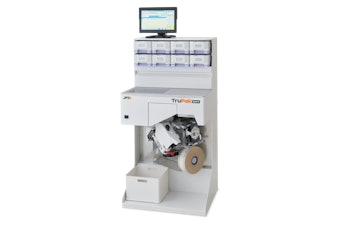"Virtual design tries to cut time out of package development—and deliver a more robust way of developing it," said Christopherson. "In scanning parts, you get a precision not capable with manual measurements. 3-D scans provide much more precise data that's visual, so you can quickly evaluate designs. Once the scan of the part, tool, or package is made, it can be rendered into a 3-D drawing. On a computer you can then simulate what happens in thermoforming to determine areas of strength in the material, to see areas where punctures could occur, or to identify how snap fits will work, and so on," he continued. The benefits: eliminating the need for extra tooling costs, and considerable time savings. A computer simulation showed how a mold of a package could be rotated and moved as necessary to examine the part.
Unlike the more traditional process where vendors generate specifications, develop tooling, then thermoform the components, Christopherson said that medical device companies could use virtual design to develop packaging. "This saves time, lowers risks, and hopefully squeezes out costs," he said. "It puts the tools in the hands of the medical device company and allows for better validation. This is the way packaging development is going to be done in the future."
"Computer simulation makes it easy to design, test, and develop your package," added Montesino's Schmitt. "With a 3-D simulation you know the thick and thin points within the material" during the thermoforming process, "and you can see how a product will fit into a part and gain a much better understanding of the process."
Hal Miller of PACE Solutions LLC, and formerly with Johnson & Johnson, noted that in 2004 J&J had no packaging recalls. He credited much of that success to "a tool for beyond compliance and zero recalls" that examines the root causes of sterile packaging recalls: materials, people, package design and testing, and equipment, validation, and control processes. For more information on MD&M East, contact Canon Communications LLC.
--By Jim Butschli, Editor
Unlike the more traditional process where vendors generate specifications, develop tooling, then thermoform the components, Christopherson said that medical device companies could use virtual design to develop packaging. "This saves time, lowers risks, and hopefully squeezes out costs," he said. "It puts the tools in the hands of the medical device company and allows for better validation. This is the way packaging development is going to be done in the future."
"Computer simulation makes it easy to design, test, and develop your package," added Montesino's Schmitt. "With a 3-D simulation you know the thick and thin points within the material" during the thermoforming process, "and you can see how a product will fit into a part and gain a much better understanding of the process."
Hal Miller of PACE Solutions LLC, and formerly with Johnson & Johnson, noted that in 2004 J&J had no packaging recalls. He credited much of that success to "a tool for beyond compliance and zero recalls" that examines the root causes of sterile packaging recalls: materials, people, package design and testing, and equipment, validation, and control processes. For more information on MD&M East, contact Canon Communications LLC.
--By Jim Butschli, Editor


















